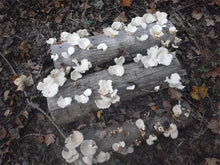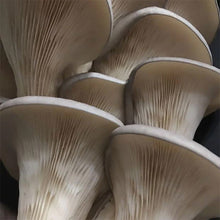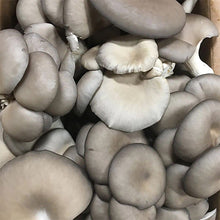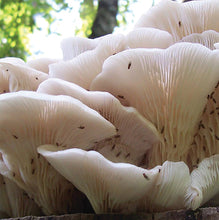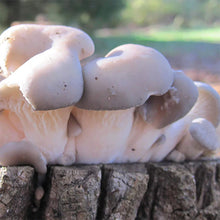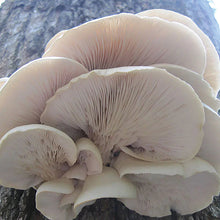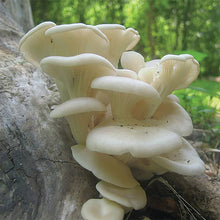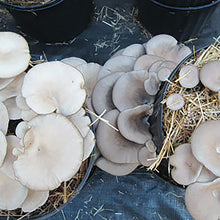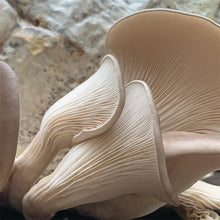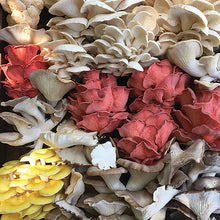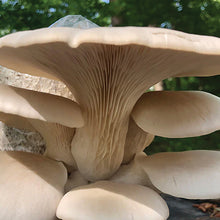
The Warm Blue Oyster - (Pleurotus ostreatus) is one of the most prolific indoor commercial fruiting strains with an extremely WIDE fruiting temperature window. Meaty and sweet, this mushroom is also known for its antiviral properties and cholesterol-lowering abilities. Optimum fruiting occurs when temperatures are between 50-80F, but it can produce as high as 95F. Outdoors it fruits well on oak, sweetgum, poplar, and many other hardwood species. Indoors we recommend fruiting this strain on pasteurized wheat straw and cotton hulls for incredible yields. This strain can grow year-round indoors and forms beautiful, thick clusters. The blue color quickly fades into a light steel-blue, grey color. Like all oysters, these mushrooms are high in protein and wonderful sautéed, grilled, or fried as a side or even the main course!
- Grows on: Hardwood Logs and Stumps (Outdoors): alder, ash, aspen, beech, birch, elm, maple, oak, sweetgum, box elder, cottonwood, willow, ailanthus, tulip poplar, pasteurized straw or Agricultural Byproduct (Indoors).
- Fruiting Temps: 50-80F.
- Availability: Year-Round.
The Aspen Oyster – (Pleurotus populinus) is a beautiful white smooth-capped oyster mushroom that is very similar to P. ostreatus. Aspen oysters grow on aspen, cottonwood, and sometimes maple but will grow on most any populus. When growing indoors, you can use a variety of substrates, including wheat, rice, straws, hardwood sawdust, cornstalks, and coffee waste. However, because this is an oyster mushroom, it can grow on various substrates. This specific mushroom will always have a white spore print with gills running decurrent down the cap to the short, sometimes non-existent stem. The cap is either flat or convex, and these mushrooms grow in a shelf-stacked-like formation with open spreading caps that are smooth and open when mature. These particular mushrooms have a very mild flavor and can easily replace button mushrooms in any recipe. Pairing well with many dishes and flavors, you can use this to replace meat or as a great source of nutrition; however, if you undercook them, you may end up with a very soft texture. The best time to look for them will be spring and summer. If you are cultivating these indoors, you can expect them to fruit every 7-10 days; on average, they flush around three times!
- Edibility and taste: Edible down to the stem, very mild taste.
- Grows on: Hardwood logs: aspen, cottonwood, and sometimes maple, will grow on most any populus.
- Fruiting temps: 60-70F
- Availability: Year Round.
The Cold Blue Oyster - (Pleurotus ostreatus) is one of the most beautiful winter mushrooms and commercial fruiting strains with an extremely low fruiting temperature window. Meaty and sweet, this mushroom is also known for its antiviral properties, so it is a great mushroom to eat and toss into a soup during the colder months. Optimum fruiting occurs when temperatures fall between 35-50F, which means a cold shock down to a near freeze is needed to produce after a flush has rested. Outdoors it fruits well on oak, sweetgum, poplar, and many other hardwood species. Indoors we recommend fruiting this strain on pasteurized wheat straw and cotton hulls for incredible yields. We like to grow this strain indoors during the winter and turn off the heat to the growing room to save on production costs, so it is a good strain to cultivate seasonally. The colder the temperature, the deeper blue the caps are!
- Grows on: Hardwood Logs and Stumps (Outdoors): alder, ash, aspen, beech, birch, elm, maple, oak, sweetgum, box elder, cottonwood, willow, ailanthus, tulip poplar.
- Fruiting Temps: Needs COLD SHOCK. Prefers fruiting 35-50; once baby mushrooms form, they can mature quickly at higher temperatures, then cold-shocked again every few weeks.
- Availability: September - March.
The Brown Oyster - (Pleurotus ostreatus) strain is very similar to the native white oyster, this strain differs in that it has a softer, inflated stem that is edible and delicious! The entire mushroom can be sliced and cooked, making it a great value for consumers. This strain can grow to almost a foot across, and the cap margin becomes a beautiful, wavy shape when mature.
The Brown oyster is light sensitive, so it does not like growing in clear containers or bags, opt for black bags or use nursery pots, buckets, or bins with holes in them. This strain becomes trapped in clear containers, and they cannot find the holes to escape. Not as sweet as the blue or elm oyster, this one is the best meat substitute and can be oiled and grilled whole for oyster sandwiches or cubed up and threaded onto kabobs.
Outdoors it fruits well on oak, sweetgum, poplar, and many other hardwood species in the spring and fall. Indoors we recommend fruiting this strain on pasteurized wheat straw and cotton hulls for incredible yields. This strain can grow year-round indoors due to its wide temperature fruiting window, forms beautiful, thick clusters, and is the most CO2 tolerant of all oyster strains. Approximately 100 plugs by weight.
- Edibility and taste: Meaty and Earthy.
- Grows on:
- Hardwood Logs and Stumps: alder, ash, aspen, beech, birch, elm, maple, oak, sweetgum, box elder, cottonwood, willow, ailanthus, tulip poplar.
- Fruiting Temps: 50-75F.
- Availability: Year Round.
Mulberry Oyster - (Pleurotus ostreatus) These mushrooms are large and meaty. You can plant them on various hardwoods outdoors and have mushrooms pretty much year-round once they start fruiting.
- Edibility and Taste: Meaty and Earthy.
- Grows On: Hardwood Logs and Stumps (Outdoors): mulberry, alder, ash, aspen, beech, birch, elm, maple, oak, sweetgum, box elder, cottonwood, willow, ailanthus, tulip poplar. Pasteurized Straw or Agricultural Byproduct (Indoors).
- Fruiting Temps: 20-75F.
- Availability: Year Round.
Pearl Oyster - (Pleurotus ostreatus) This strain of the oyster mushrooms is usually white, but it can vary anywhere from white to gray to brown. It is a common temperate oyster mushroom, and it can grow on many different substrates like paper, cardboard, straw, sterilized sawdust, and other agricultural waste. They produce gorgeous firm, medium-sized clusters.
- Colonization Temps: 70-75F.
- Fruiting Temps: 60-70F.
Pohu Oyster - (Pleurotus ostreatus) This is a Hungarian variety of brown mushrooms, also a hardwood-loving strain. This strain is photosensitive and should be grown in opaque bags if cultivated in substrates other than logs.
- Colonization Temps: 70-75F.
- Fruiting Temps: 50-75F.
Tarragon Oyster - (Pleurotus euosmus) This is a beautiful tarragon-smelling oyster mushroom. This tasty mushroom smells slightly like anise and has a marbling of light grey on white. It grows a lot like P. ostreatus, with a cap that is curved outward and later on becomes depressed in the center. These mushrooms are generally very brittle, so you’ll want to harvest them gently. The gills are long and decurrent, running down the mushroom to the stem. The stem is short, or sometimes it may not be present at all. You can experiment with different growth mediums and see what it grows on, you would be surprised at the number of things you can produce these mushrooms on! After full colonization, you can expect fruiting bodies to develop after around 4-8 days. When cultivating these mushrooms indoors, you can expect about three flushes around two weeks apart.
- Edibility and taste: Taste of tarragon and slightly anise, edible to the stem.
- Grows on: Hardwood logs, hardwood sawdust, cottonseed hulls, straw, coffee grinds, and many other substrates.
- Fruiting Temps: 70-80F.
- Availability: Year-round.
Gray Dove Oyster - (Pleurotus ostreatus) This strain colonizes well on straw and hardwoods. It is a sturdy clustering mushroom, colors varying from deep blue when they start out as pins, to a grey blue when it matures. Great taste on this one. This is good to plant in an unheated greenhouse on straw in cold weather.
- Colonization Temps: 70-75F.
- Fruiting Temps: 50-75F.
Sporeless Oyster - (Pleurotus ostreatus) This brown oyster mushroom strain doesn’t produce spores. It was developed as an experiment by crossing strains of oyster mushrooms. This strain is promising for large farms where spore loads can be problematic for workers. Large amounts of spores floating around in workspaces can cause lung problems.
- Colonization Temps: 70-80F.
- Fruiting Temps: 55-75F.
King Black Pearl Oyster - (Pleurotus ostreatus) A hardwood-loving commercial strain that’s a pearl oyster hybrid. According to Superior Mycology, these guys combine regular mushrooms' robust flavor and king oysters' firm texture. It was developed a couple of years ago in Japan by hybridizing king oysters and regular oyster mushrooms. The name it got is Shimofuri Hiratake which translates to Marbled Oyster Mushroom. According to Mountaintop Mushrooms, it has a beautiful umami flavor, great in Asian dishes like stir fries or soups.
Lovely, tender, meaty stems great for sauteeing and grilling, they would hold their shape very nicely when pickled or fermented. It is extremely versatile, has great texture, and is packed full of flavor. It also yields very well and has a great shelf life. It is an excellent meat replacement.
- Colonization Temps: 70-75F.
- Fruiting Temps: 50-68F.
All units have approximately 100 plugs by weight.











